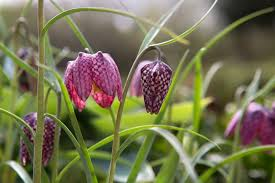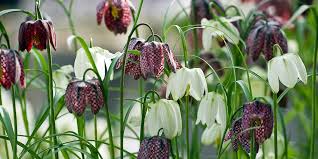Fritillaria, commonly known as fritillaries, are perennial bulbs from temperate regions of the Northern Hemisphere. This genus, which includes around 130 species, produces stunning bell-shaped flowers that bloom in spring. These plants thrive in various habitats, from dry meadows to moist soils, and are known for their distinctive bell-like flowers and scaled bulbs.
Quick Overview
- Common name(s): Fritillary, fritillaria
- Plant type: Perennial bulb
- Hardiness Zones: 4–9
- Native to: Temperate Northern Hemisphere
- Bloom season: Spring
- Soil: Well-drained, organically-rich loam
- Exposure: Full sun to part shade
- Watering needs: Moderate
Despite their rich history—dating back over 500 years and once cultivated in royal gardens—fritillaries remain underappreciated in horticulture. These bulbs have long been valued for their ornamental beauty and, in some regions, for medicinal use.
How to Grow Fritillarias
Fritillarias come in a variety of shapes and sizes, making them versatile for different garden settings. Smaller species like F. meleagris (Snake’s Head Fritillary) are excellent for naturalizing in meadows, while larger species, such as F. imperialis (Crown Imperial), are perfect for dramatic borders or containers.

Planting Location
- Light: Full sun is ideal, though fritillaries can tolerate some shade.
- Soil: These bulbs prefer loamy, well-draining soils with a pH of 6.0 to 7.0. Adding compost or grit can improve drainage.
- Watering: Keep the soil moderately moist, but not soggy. Fritillaries are resistant to drought once established.
Fertilizing
Apply a balanced fertilizer in early spring before flowering to ensure healthy growth, especially for larger species. Annual fertilization supports bulb vitality and flower production.

Popular Fritillaria Species
- F. affinis (Chocolate Lily): Native to North America, this species features brownish-purple flowers with a striking checkerboard pattern.
- F. imperialis (Crown Imperial): Known for its large, bright orange flowers, this species reaches up to 4 feet tall and thrives in full sun.
- F. meleagris (Snake’s Head Fritillary): A smaller species with delicate checkerboard petals, perfect for moist, naturalized areas.
- F. persica (Persian Fritillary): This species boasts unique gray-green leaves and black-purple bells, making it a striking addition to any garden.
Propagation
Fritillarias can be propagated by planting bulbs, seeds, or dividing mature plants:
- Bulbs: Plant fritillaria bulbs in fall, spacing them several inches apart in rich, well-draining soil. Larger species should be planted deeper (8 inches) compared to smaller ones (4 inches).
- From Seed: Growing fritillarias from seed can take several years, but it is possible with patience. Seeds require cold stratification before germinating.
- Dividing Bulbs: Every few years, you can divide mature plants in fall. Bulbils, or small bulbs, can be separated from the main bulb and replanted.
Managing Pests and Diseases
Fritillarias are generally pest-resistant, but there are a few issues to watch out for:
- Scarlet Lily Beetle: A common pest of lilies, it can also affect fritillarias. Check for red beetles and their larvae and remove them promptly.
- Diseases: Fritillarias are susceptible to bulb rot if planted in overly wet conditions. Ensure good drainage and avoid watering the foliage.
Conclusion
Fritillarias are low-maintenance, beautiful, and hardy bulbs that add variety and elegance to spring gardens. With proper care, these plants will reward you with their unique flowers and become a lasting feature in your landscape.
